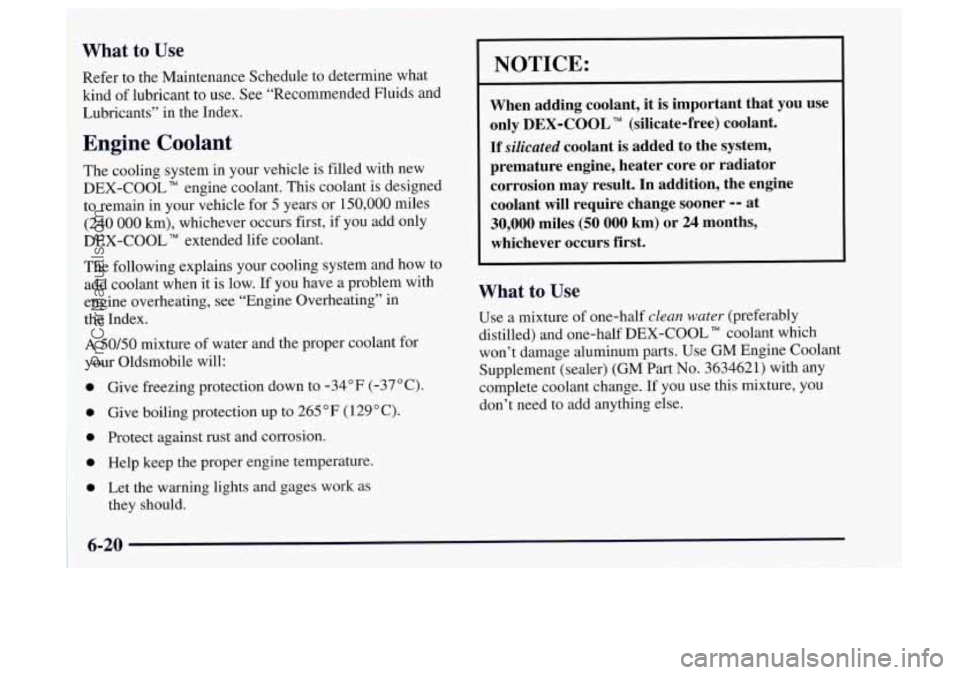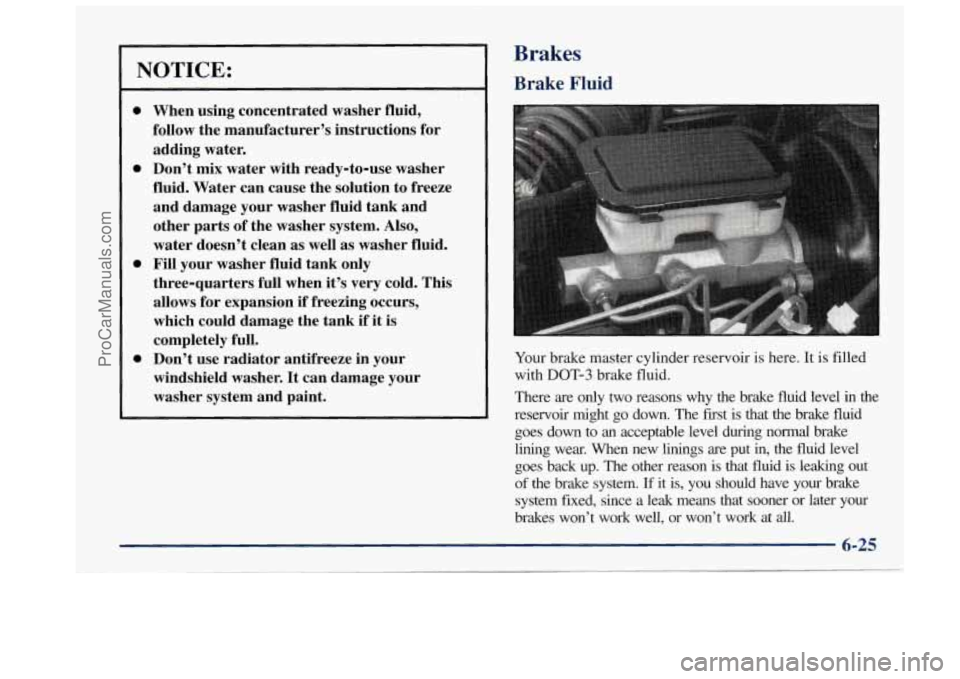Page 240 of 358

1
; What to Use
I Refer to the Maintenance Schedule to determine what
’ kind of lubricant to use. See “Recommended Fluids and
i Lubricants” in the Index.
1 , I Engine Coolant
; The cooling system in your vehicle is filled with new
1 DEX-COOL” engine coolant. This coolant is designed
I to remain in your vehicle for 5 years or 150,000 miles
I (240 000 km), whichever occurs first, if you add only
~ DEX-COOL” extended life coolant.
I i The following explains your cooling system and how to
i
~
i
add coolant when it is low. If you have a problem with
engine overheating, see “Engine Overheating” in
the Index.
I
A 50/50 mixture of water and the proper coolant for
1 your Oldsmobile will:
’ 0 Give freezing protection down to -34°F (-37°C).
~ 0 Give boiling protection up to 265 “F (129°C). I
~ 0 Protect against rust and corrosion.
0 Help keep the proper engine temperature.
0 Let the warning lights and gages work as
they should.
NOTICE:
When adding coolant, it is important that you use
only
DEX-COOL TM (silicate-free) coolant.
If silicated coolant is added to the system,
premature engine, heater core or radiator
corrosion may result. In addition, the engine
coolant will require change sooner
-- at
30,000 miles (50 000 km) or 24 months,
whichever occurs first.
What to Use
Use a mixture of one-half clean water (preferably
distilled) and one-half DEX-COOL
TM coolant which
won’t damage aluminum parts. Use GM Engine Coolant
Supplement (sealer) (GM Part
No. 3634621) with any
complete coolant change.
If you use this mixture, you
don’t need to add anything else.
ProCarManuals.com
Page 241 of 358
1 NOTICE:
Adding only plain water to your cooling system
can be dangerous. Plain water, or some other
liquid like alcohol, can boil before the proper
coolant mix
will. Your vehicle’s coolant warning
system is set for the proper coolant mix. With
plain water or the wrong mix, your engine could
get too hot but you wouldn’t get the overheat
warning. Your engine could catch fire and you or
others could be burned. Use a
50150 mix of clean
water and
DEX-COOL TM coolant.
If you use an improper coolant mix, your engine
could overheat and be badly damaged. The
repair cost wouldn’t be covered by your
warranty.
Too much water in the mix can freeze
and crack the engine, radiator, heater core and
other parts.
If you have to add coolant more than four times a year,
have your retailer check your
cooling system.
NOTICE:
If you use the proper coolant, you don’t have to
add extra inhibitors or additives which claim to
improve the system. These can be harmful.
6-21
ProCarManuals.com
Page 242 of 358
Checking Coolant
When your engine is cold, the coolant level should be at
ADD, or a little higher. When your engine is warm, the
level should be up to
FULL HOT, or a little higher.
Adding Coolant
If you need more coolant, add the proper coolant
mixture at the coolant recovery tank.
A CAUTION:
-
Turning the radiator pressure cap when the
engine and radiator are hot can allow steam and
scalding liquids to blow out and burn you badly.
With the coolant recovery tank, you will almost
never have to add coolant
at the radiator. Never
turn the radiator pressure cap
-- even a
little -- when the engine and radiator are hot.
Add coolant mixture at the recovery tank, but be careful
not to spill it.
' ,A CAUTION:
You can be burned if you spill coolant on hot
engine parts. Coolant contains ethylene glycol,
and it will burn if the engine parts are hot
enough. Don't spill coolant on
a hot engine.
I
6-22
ProCarManuals.com
Page 243 of 358
Radiator Pressure Cap Thermostat
Engine coolant temperature is controlled
by a thermostat
in the engine coolant system. The thermostat stops the
flow of coolant through the radiator until the coolant
reaches
a preset temperature.
Power Steering Fluid
NOTICE:
Your radiator cap is a 15 psi (105 kPa)
pressure-type cap and must be tightly installed
to
prevent coolant loss and possible engine damage
from overheating. Be sure the arrows on the cap
line up with the overflow tube on the radiator
filler neck.
6-23
ProCarManuals.com
Page 245 of 358

NOTICE:
0
0 0
0
When using concentrated washer fluid,
follow the manufacturer’s instructions for
adding water.
Don’t mix water with ready-to-use washer
fluid. Water can cause the solution to freeze
and damage your washer fluid tank and
other parts of the washer system. Also,
water doesn’t clean as well as washer fluid.
Fill your washer fluid tank only
three-quarters full when it’s very cold. This
allows for expansion if freezing occurs,
which could damage the tank if it is
completely full.
Don’t use radiator antifreeze in your
windshield washer. It can damage your
washer system and paint.
Brakes
Brake Fluid
Your brake master cylinder reservoir is here. It is filled
with
DOT-3 brake fluid.
There are only two reasons why the brake fluid level in the
reservoir might go down. The fiist is that the brake fluid
goes down to an acceptable level during normal brake
lining wear. When new linings are put
in, the fluid level
goes back up. The other reason is that fluid is leaking out of the brake system. If it
is, you should have your brake
system fixed, since a leak means that sooner or later your
brakes won’t work well,
or won’t work at all.
6-25
ProCarManuals.com
Page 250 of 358
Bulb Replacement
Before you replace any bulbs, be sure that all the lamps
are
off and the engine isn’t running. See “Replacement
Bulbs”
in the Index for the proper type of bulb to use.
Halogen Bulbs
A CAUTION:
Halogen bulbs have pressurized gas inside and
can burst if you drop or scratch the bulb. You
or
others could be injured. Be sure to read and
follow the instructions on the bulb package.
Composite Headlamps
1. Open the hood.
2. Remove the black
protective
caps from the
removal pins at
the top
of the radiator support.
Use
a hex socket to
unscrew the pins.
3. Pull the headlamp lens
assembly out.
4. Unplug the electrical connector.
6-30
ProCarManuals.com
Page 309 of 358
I Short TripKity Maintenance Schedule I
- When doing frequent trailer towing.
- Uses such as found in taxi, police or
delivery service.
If you do not use your vehicle under any of these
conditions, the fluid andfilter do not require changing.
DATE
ACTUAL MILEAGE -1
Il
150,000 Miles (240 000 km)
0 Drain, flush and refill cooling system
(or every
60 months since last service,
whichever occurs first). See “Engine
Coolant” in the Index for what to use.
Inspect hoses. Clean radiator, condenser,
pressure cap and neck. Pressure test
cooling system and pressure cap.
An Emission Control Service.
DATE
SERVICED BY: ACTUAL MILEAGE
7-27
ProCarManuals.com
Page 320 of 358
Long Tripmighway Maintenance Schedule
100,000 Miles (166 000 km) (Continued)
DATE
SERVICED BY: ACTUAL MILEAGE
150,000 Miles (240 000 km)
0 Drain. flush and refill cooling system
(or every
60 months since last service,
whichever occurs first). See "Engine
Coolant"
in the Index for what to use.
Inspect hoses. Clean radiator, condenser,
pressure
cap and neck. Pressure test the
cooling system and pressure cap.
AI! Eulissiot1 Co11tt-d St~r\~ict~.
DAI'E ACTUAL hIILEAGE SERVICED BY
7-38
ProCarManuals.com